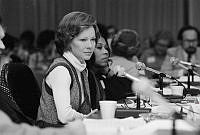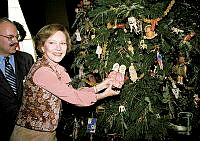Mary Lincoln

Mary Todd was born on December 13, 1818, in Lexington, Kentucky. She was the fourth of seven children born to Robert Smith Todd and Eliza Ann Parker Todd. Her mother Eliza died when Mary was six years old. Her father, a wealthy businessman and slave owner, remarried Elizabeth Humphreys in 1826. The following year, Mary began attending Ward’s Academy and at age fourteen she entered Madame Mentelle’s French School for Girls, a boarding school near her family home in Lexington.1
In 1839, she moved to Springfield, Illinois, to live with her sister Elizabeth Edwards. There Mary met Illinois House Representative Abraham Lincoln and the couple married on November 4, 1842. She gave birth to four sons: Robert Todd, Edward Baker, William (Willie) Wallace, and Thomas (Tad). When her husband was elected to the United States House of Representatives in 1846, the Lincolns moved to Washington, D.C. where Mary supported her husband’s political career and raised her family, making frequent trips to Lexington and Springfield. In 1849, after Abraham Lincoln finished his term in Congress, the family returned to Springfield where he practiced law. During this time, Mary experienced loss and grief caused by the passings of her father and three-year-old son Edward. As her husband emerged as a national political figure, she continued to support his career, hosting visitors and political allies at their home.2
When Abraham Lincoln became president on the eve of the Civil War in March 1861, Mrs. Lincoln moved into the White House with her sons, Willie and Tad. In charge of a wartime White House, the first lady kept up with the shifting demands on her time, serving as a hostess while coping with reduced privacy and increased public scrutiny. Due to wear and tear from frequent use, Mrs. Lincoln began redecorating the White House, recarpeting the State Rooms, and purchasing ornate furniture, including the famous Lincoln bed. She received negative press attention for her efforts, as the media accused her of lavish spending during a costly war. Despite these criticisms, Mrs. Lincoln supported various efforts associated with the war, including local contraband camps, places where formerly enslaved refugees lived after they fled the South. In 1862, she invested $200 into the Contraband Relief Association, an organization associated with her friend and dressmaker Elizabeth Keckly, and oral histories note that Mrs. Lincoln contributed money and sent gifts to individuals at the camps.3
Tragedy struck repeatedly during her tenure as first lady. On February 20, 1862, Willie died of typhoid fever. The White House was draped in black crape, and Willie’s funeral took place in the East Room, though his mother was unable to attend. Mrs. Lincoln struggled with her sorrow; Keckly wrote: “Mrs. Lincoln’s grief was inconsolable. The pale face of her dead boy threw her into convulsions.” Seeking comfort, she turned to spiritualism, even hosting seances in the Red Room.4
Three years later, on April 14, 1865, Mary witnessed her husband’s assassination while attending a play at Ford’s Theatre. She did not attend his funeral. President Andrew Johnson allowed Mrs. Lincoln to stay at the White House, and she remained there for nearly six weeks after the assassination, before departing on May 22, 1865.5 In a letter to Senator Charles Sumner shortly before her departure, she wrote: “I go hence, broken hearted, with every hope almost in life—crushed.”6
Mary Lincoln settled in Chicago where she found herself in a difficult financial situation, struggling to pay debts and fighting for a widow’s pension. In 1867, she went to New York with Keckly where she attempted to sell her dresses, resulting in public ridicule and scrutiny.7 Her troubles were further compounded after her youngest son Tad died in 1871 at the age of eighteen. In 1875, as she struggled with grief and likely depression, her only surviving son, Robert, instigated a jury trial to determine Mary Lincoln’s sanity. The trial, featuring numerous witnesses, resulted in her admittance to an asylum against her will. She remained at the facility for several months before managing to secure her freedom through her friends and lawyers. She was eventually released into the custody of her sister, Elizabeth Edwards.8 After resisting her son’s repeated efforts to have her institutionalized, Mary Lincoln traveled to Europe and settled in France. Her declining health forced her to return to the United States, and on July 16, 1882, she died from a stroke at her sister’s home in Springfield.9
Click here to learn more about the household of the Lincoln family.
Footnotes & Resources
- “The Todd Family,” Mary Todd Lincoln House, accessed January 11, 2023, https://www.mtlhouse.org/the-todd-family; “Enslaved Men and Women in the Todd Household,” Mary Todd Lincoln House, accessed January 11, 2023, https://www.mtlhouse.org/slavery; Jean H. Baker, Mary Todd Lincoln: A Biography, (New York: W.W. Norton & Company, 1987), 37-45.
- Catherine Clinton, Mrs. Lincoln: A Life, (New York: HarperCollins Publishers, 2009), 32-33; 85-87, 111-112; “Abraham Lincoln,” American Battlefield Trust, Accessed January 17, 2022, https://www.battlefields.org/learn/biographies/abraham-lincoln.
- William Seale, The President’s House, (White House Historical Association, 2008), 373-377; Sarah Fling, Washington, D.C.’s ‘Contraband’ Camps, The White House Historical Association, July 22, 2020, https://www.whitehousehistory.org/washington-d-c-s-contraband-camps; Elizabeth Keckly, Behind the Scenes, or, Thirty years a Slave and Four Years in the White House: Electronic Edition, (University of North Carolina at Chapel Hill: Documenting the American South, 1999), 114, https://docsouth.unc.edu/neh/keckley/keckley.html.
- Keckly, 104., 1999), 104, .https://docsouth.unc.edu/neh/k...; Alexandra Kommel, Seances in the Red Room: How Spiritualism Comforted the Nation During and After the Civil War, The White House Historical Association, April 24, 2019, https://www.whitehousehistory.org/seances-in-the-red-room.
- Although biographies of Mary Lincoln by Jean H. Baker, Catherine Clinton, Justin G. Turner, and Linda Levitt Turner state that she left the White House on May 23, 1865, primary source evidence suggests that she left on May 22, 1865. A journal entry from commissioner Benjamin French dated May 24, 1865, states the following: “Mrs. Mary Lincoln left the City on Monday evening at 6 o’clock, with her sons Robert &Tad (Thomas). I went up and bade her good-by, and felt really very sad, although she has given me a world of trouble.” The Monday in question would be May 22, 1865. French’s account is also supported by newspaper evidence. An article in the Evening Star from May 22, 1865, states: “Mrs. Lincoln has decided upon leaving Washington this afternoon at 6 o’clock for her home in Springfield, Ill. She will be accompanied by Capt. Robert Lincoln, Master Todd Lincoln and others.” It is unclear where the May 23, 1865, date comes from in secondary sources, however, it is possible that date is confused with an event from May 23 mentioned by French earlier in the same journal entry: “Yesterday morning it commenced. The ninth corps[,] numbering 15,000 men, formed on East Capitol Street quite early in the morning.” He goes on to describe a great celebration culminating at the White House with President Andrew Johnson and General Ulysses S. Grant in attendance. Jean H. Baker asserts that Mary Lincoln left the White House on the day of this celebration: “She left on a special day. For weeks official Washington had been planning a victory celebration, and on May 23, at the very hour that Mary Lincoln had chosen for her departure, the blue uniformed veterans of the Army of the Potomac were swinging up Pennsylvania Avenue, regimental flags snapping in the wind, bands playing in celebration of the army’s magnificent triumph in Virginia. On the reviewing stands in front of the White House—where Mary Lincoln might have been—President Johnson and General Grant took the soldiers’ salutes.” Baker cites the Benjamin French journal entry, meaning it is likely the date of her departure was confused with the date of this celebration based on his account. Benjamin Brown French, Witness to the Young Republic: A Yankee’s Journal, 1828-1870, ed. Donald B. Cole and John J. McDonough, (University Press of New England, 1989), 478-479; Evening Star, May 22, 1865, https://infoweb-newsbank-com.eu1.proxy.openathens.net/apps/readex/results?p=EANX&f=advanced&sort=YMD_date%3AA&val-base-0=Mrs.%20Lincoln&fld-base-0=ocrtext&fld-nav-0=YMD_date&val-nav-0=May%2021%2C%201865%20-%20May%2025%2C%201865; Clinton, 256; Baker, 253.
- Seale, 406-410; “Letter from Mary Lincoln to Charles Sumner, May 9, 1865” in, Justin G. Turner and Linda Levitt Turner, Mary Todd Lincoln: Her Life and Letters, (New York: Fromm International Publishing Corporation, 1987), 227-228.
- Baker, 264-272; Elizabeth Keckly, 302-312.
- In the winter of 1875, Mary Lincoln traveled to Florida where she lived for several months. While there, she had a dream or vision that her son, Robert, was dying. She quickly sent telegrams to her son and his law partner and returned to Chicago by train. Upon arrival, she discovered that Robert was in fine health. Robert was alarmed by her erratic behavior and after consultation with lawyers and doctors, turned to the courts in an attempt to send her to an asylum. On May 19, 1875, Mrs. Lincoln opened her door and was surprised to find several men there to escort her to the courthouse for a hearing where a jury would determine her sanity. Lawyer Leonard Swett showed her a writ of arrest charging her with lunacy. She had no idea that her son Robert had instigated the arrest and jury trial. Upon arrival to the courthouse, she discovered that Robert had assembled seventeen witnesses to testify to her insanity, including doctors, store clerks, maids, and others. Mrs. Lincoln, not knowing about the arrest or hearing, brought no witnesses in her defense. Her lawyer, Isaac Arnold, did not provide any rebuttal or cross examination. The all-male jury deliberated and decided Mrs. Lincoln was insane and should be confined to an asylum. She spent several months at Bellevue Place, an asylum in Batvia, Illinois, before managing to secure release. Baker, 317-342; “Biography of Mary Todd Lincoln,” Mary Todd Lincoln House, accessed January 17, 2023, https://www.mtlhouse.org/biography; Jason Emerson, The Madness of Mary Lincoln, (Southern Illinois University Press, 2007), 44-61.
- Baker, 354-355; Biography of Mary Todd Lincoln,” Mary Todd Lincoln House,
accessed January 17, 2023, https://www.mtlhouse.org/biography; Clinton, 329-331.





































